Jpw’s new mini R2 raft will give your rafting experience new legs!

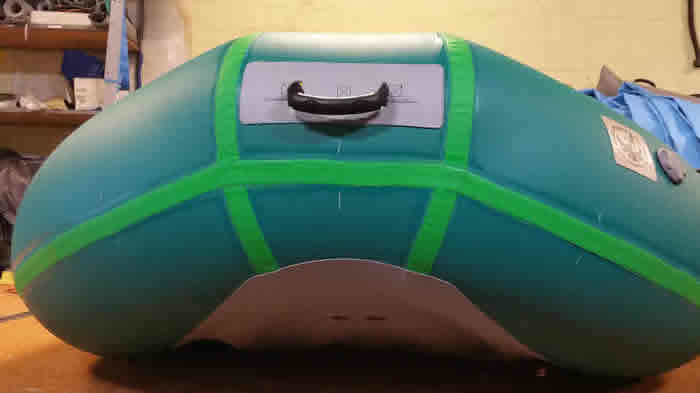
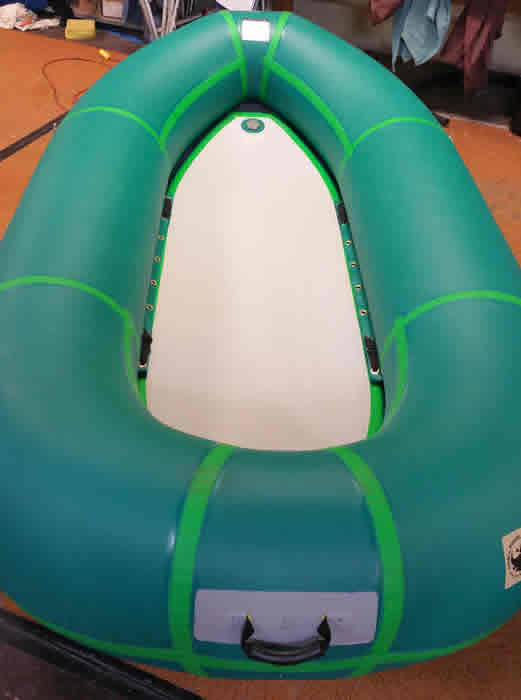
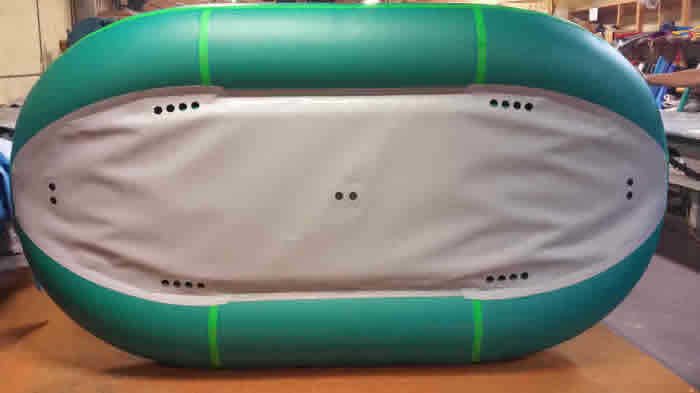
General specifications:
11 ft over all length. 68 inch over all width. It will have 5 chambers. 2 thwarts, 2 main tube chambers, and 1 curved drop stitch floor chamber. The end section is 15 inches in diameter, and that means that the curved section tapers from 19 to 15 inches. 4 D rings, 2 handles, We are still working out some details on price and floor design. Weight including double bottom 20 inches wide and made of ultra heavy duty 42 oz material, and 2 cross thwarts is still ony 70 lbs.
We would like to challeng you to find a better constructed lighter weight more durrable raft this size.
What about cost: 3979.00.
If you do not need thwarts remove 310.00
If you do not need a double bottom remove 448.00
Then the cost will be 3221.00 and the weigth will be 58 lbs
If you would like to see this computer model in 3D, follow these instructions:
1 Go to this web site and download the edrawing viewer for your application.
2 download this file and open it up with the edrawing application.
This web page started out to be an advertisement for a new product we were putting on the market. It got progressively harder to build as I thought I was learning about how compound curves interact with inflation pressure. As the design got more complex, the computer models turned out boats that did not work the way that they supposed to work. That is why this page turned out to be a study in the effects of air pressure and stretch on design and patterning. Thank you for allowing us to show how difficult some designs can be.
If you care to know more keep reading.
First let’s talk about a new floor design we are working on. The Grasshopper is complete in the way we originally designed it, but after another year of listening to customers, and getting their feedback on our designs, we have decided to experiment on the light green model, and the Sandstone model. The experiment involves a lace in floor that will not trap sediment between the main floor and the inflatable floor. These next two images show what we are thinking. We have received some great inputs from customers over the past year, so please do not hold back. Let us know what you think.
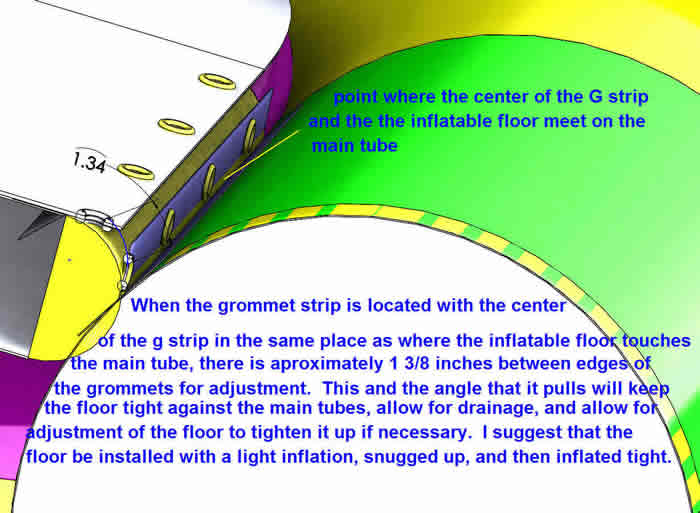
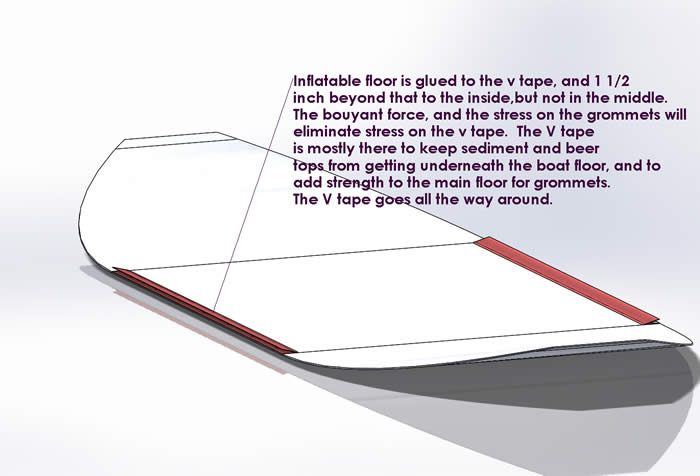

The bottom line about inflatable design is that when inflation pressure stretches something out of alignment, a designer must use a combination of intuition, and computer design to make it work. This we did, and we now have a successful Grasshopper design.
This is the final product (without an inflatable floor).

This is the final product on top of the other two models. The bottom is the first attempt with no taper in the curved section, and it is light green. The second is the tan unit with a tapered end section but the end section does not fit as nicely on the curved tapered section as we would have liked. The third unit is the dark green model and it is the final product.


It also has a 9.5 inch kick and that was what we expected to see when we did the tan model.

If you are interested in how this process developed, please read on. The rest of this page is about how we figured this out. In the end, the second one we made (the tan one) was close enough to estimate what stretch of inflation was doing to the end. We were able to compensate for that by taking the computer generated pattern, rotating it inward to the mid-point where the inside seam meets the middle of the end section. In other words, we looked at the wrinkles and decided that removing an inch form the inside, and adding ½ inch on the outside of this pattern would take the wrinkles out. Intuition in this case worked well for this product. It looks real sweet. I can’t wait to see it with a floor.
Read more about the design of the Grass hopper
Our first raft named after an insect was a Dragon fly because of the elegance it uses to float over the water and capture other insects. Then came the Mosquito because of its small size and weight. Now we have a new style. The Grasshopper is carrying on the tradition of insect names. This time the Grass hopper is named because this boat will deliver extra power to any rafting experience. In other words the Grass hopper is known for how its legs produce power to hop from plant to plant. Our Grasshopper gets its power form the people paddling it. In other words, you are the legs! Extra light weight (estimated at less than 50 lbs including a drop stitch floor and cross foot thwarts) compared to other boats its size, that can weigh between 1.5 and 2 times as much. Hydrodynamic curved drop stitch floor design (like all of our self-bailing whitewater rafts) Provides great tracking, and the fastest hull speed of any boat its size on the market.
Because it is still our busy season, we have not finished the design yet, or have we determined a price. We hope that we can introduce that later after the next version is complete.
let's look at the one we just made (also in the picture above). We are still in the development phase, and are asking the white water community for feedback on this design. We hope that you like the direction that we are taking.
You will note that in this spec sheet there are some differences between what is designed and what actually came out. This happens because inflation over a curved surface changes the basic dimensions. Now that we know how it will deform under inflation, we can design the next version with these issues in mind, and get closer to the intended shape.
So what are the steps?
The first step came from the design process developed to make stand up paddle boards, and curving the drop stitch like we do in our self bailing white water raft designs. We took these design concepts and designed a Curve tube raft. We do not especially like the 19 inch diameter end. We think it will work better with tube that curves toward the end in a continuous taper. Therefore, we decided on the next version to make it taper form 19 to 15 inches in the front along that taper section.
One step at a time: Now we have this second design. It has a tapered and curved section. This will increase the inside of the cargo compartment 3 ½ inches.
Here is what we know: We know how much the boat shrinks inward and downward because of the fabric inflation dynamic. We will be able to adjust for those changes, and we will see how close we can get to this size in the illustration below with dimensions. This is the size we should shoot for in a R2 whitewater raft based on our experience, and because we are more prone to expedition boating and carrying cargo even on small stretches when the expedition is just a couple of days. These next immages are the next design. I can send over 3d edrawing files to any one interested in seeing these represened in 3D. It is interesting to have both The original and the updated model spinning around in space if you use two screens on your computer.
Please Contact me at my new G mail adress if you would like to offer any direction to this design. ejkloepfer.jpwinc@gmail.com



June 7, 2016
It has been more than a month since we started this project. We have received a lot of good feedback from customers, and potential customers. I would like to thank Luke Martinez from Wilderness Canyon Adventures (http://wildernesscanyonadventures.com/). He still uses our pack cats as cargo rigs on low water in the later season on the Chetco River on the Southern Oregon Coastal Range. He uses Air pumas when the water is higher. Good feedback !
Before I could finish the project, I was given the task to design a new Ik. In that process, I thought that I would try to make the Ik like the grasshopper. However I knew that we could not make a curve meet the end with that tight of an angle, so I put in a miter and angled front end section to make the end pointed, and to give the boat an easier to produce geometrical shape. Like the original grass hopper (light Green) the shape changed from the computer design. I knew that this would happen, and would need to compensate. I will say more about why this is important to the Grasshopper design later.

After all of these designs that did not quite work, I followed my plan to make a curved tapered tube grasshopper. In this picture it is blown up tight, to take some of the wrinkles out of the front. It also has geometry that changes because of the way the curvature meets the end section. For instance the end is a bit oblong, and flat where the seams meet on the outside.


The next step was to take all of this to Animas River Days, and ask potential customers about the design. One of my best product testers, Jeff Hammond, was there, and he gave me a lot of good feedback. I was able to talk to many other paddlers who have tried other boats this size, and they all liked the light weight and the shape of the tan tapered curve tube unit. The result of all of this was to decide to make a Grasshopper with a mitered end section like the Ik design. I thought that the taper should be smaller, but Jeff talked me into the idea that the kick is more important, and when I computer modeled the design with a 15 inch taper I liked it. So the smaller 12 inch taper is off the table for a more comfortable paddle captain position at 15 inches.
To summarize with pictures:
We did not like the shape of the first grasshopper and resolved to make a tapered tube design.
First we made an inflatable kayak design with a sectioned miter end to compensate for the geometry involved.
This is what we were shooting for:
This is what we got (sitting on top of the original green gh). 3.5 inch kick, and 21 inches wide between the tubes.

Then we made the grasshopper with the tapered curved section, and this was the result.

Notice what happens when we only inflate one end. It is stretched very wide. We compare that to the Ik design, and it does not stretch wide. This indicates that the better design for the end is more like the IK end miter design.

Now the design is at the cross roads. There are some real issues with stretch from inflation pressure, in this design, that still need to be resolved. The tapered tube concept actually stretched wider than the original Grasshopper at 67 inches, and the original Grasshopper was 63 inches wide. Both were designed to be 65 inches. Since the only difference is the curved and tapered side tube, it can only be concluded that the end patterns make the difference, and since the IK does not have the stretch-out issue that the tan tapered tube grasshopper has, it is assumed that the new pattern with the IK style mitered end condition, will not stretch it out as much. For this reason the patterns will remain designed for 65 inches wide.
On the kick issue:
The original (Lite green) experienced a downward kick on the tubes of 1.75 inches. It eventually kicked to 6.5 inches. The tan tapered curve experienced an upward kick of plus .75 inches. It actually kicked ¾ of an inch higher at around 10.5 inches than the design. The kayak kicked down 4.5 inches, and the top of the miter end is even with the top of the main section. This could be explained by the way these were cut. The main section being cut 90 degrees to the cut on the main section of the grasshopper. Apparently there is also some crooked scrim in the fabric because when it is cut in this direction, it tends to camber in the main section. Therefore the situation of the IK downward kick is ignored, and the new grasshopper is designed with these dimensions, and see how close it gets to this design.
After all of this work, I expect that the new design will kick downward slightly, and perhaps outward slightly, but we will compensate for that by putting a stiff kicked Drop stitch floor inside.
JPW is experiencing our busiest year ever. with a lot of white water products, and almost every industrial production produce being made as well. The time line on this new design is unknown because of the work load. However we do want to get the new IK model and the new Grasshopper finished before the end of the summer. We appreciate your interest in the design process on something that is changed so much by the pressure of inflation, but we are certain that it will be a very fun boat when it is finished.
If you want to see the 3D model of the next version, that you can spin around and zoom in and out of, go to this web site and download the edrawings viewer.
http://www.edrawingsviewer.com/
Then open this file that you can download here. Next push the animate button at the bottom left of your screen. Finally to find our what other things you can do with Edrawings, go to this web site and read up on them.
http://www.jpwinc.com/pages/solidworkssoftware.html
Thank you everyone for all your help with this.
Update Aug 3, 2016:
The latest Design change even with all of that theory was a quite a failure.


In this second image one can clearly see the differences between the ends on the inside. When this happened, I had to take a break.
So what is happening to the Grasshopper design? I am not sure. We had some large contracts that came up and I had to drop the idea for a while. I also have to sort out what is happening under inflation and why the design does not inflate the way it should. If I do figure this out, it will be another mile stone in my 34 year career as a plastic welder, and designer of inflatable boats. Until that happens, I will continue on with some of the other very cool projects that we have invested out time and energies in. One may be the introduction of the Mini Dragon fly instead of the grasshopper design, or perhaps take one of the earlier dragonfly models that were more successful and modify them to work the old fashioned way. The tapered tube design on the dragonfly is rather complex to produce, and I will have to come back to it after the season winds down a bit. I regret the failure, and I would like everyone to know that we work hard on designs, and sometimes they fail.
We often learn more from our failures than from our successes. This is a big one, and it remains to be seen what we will learn from this. Rest assured it will be something good. Thanks for your interest and we will keep everyone in touch on what happens next when it happens.
PS
At JPW we have decided to finish the two bottom Grasshoper boats, and we have decided to give it one more go. I have been looking at these for some tme inthe front of the shop, and It is my oppinion that we can fudge some of the curves to make the design curves a bit straighter. However if anyone wants a deal, have a look at our end of season boat sale prices. These two boats will be in that line up.
Sincerely,
Jack
home | products | pictures & information | find a dealer | river stories & testimonials | related info | FAQ | contact us
Order inquiries: shop.jpwinc@gmail.com
Custom & Prototype inquiries: pschoser.jpwinc@gmail.com
© 2011 Jack's Plastic Welding, Inc
Toll Free 1-800-742-1904
P. 505-334-8748, F. 505-334-1901
